小学英语教学设计 Instructional Design for Primary En
INSTRUCTIONAL DESIGN FOR.docx教学设计
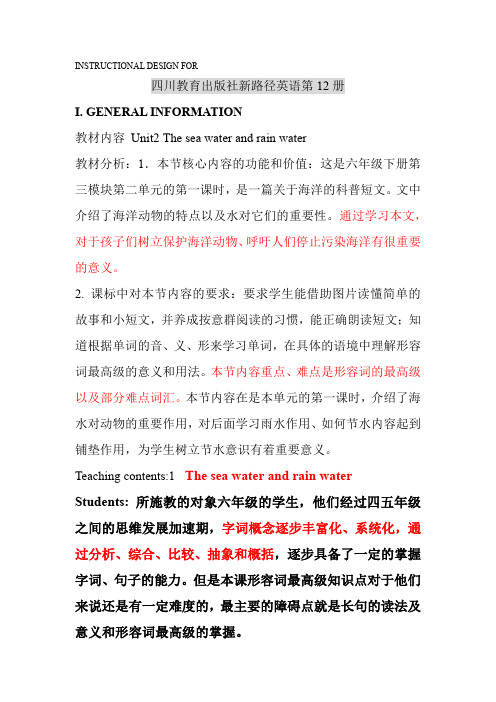
INSTRUCTIONAL DESIGN FOR四川教育出版社新路径英语第12册I. GENERAL INFORMATION教材内容 Unit2 The sea water and rain water教材分析:1.本节核心内容的功能和价值:这是六年级下册第三模块第二单元的第一课时,是一篇关于海洋的科普短文。
文中介绍了海洋动物的特点以及水对它们的重要性。
通过学习本文,对于孩子们树立保护海洋动物、呼吁人们停止污染海洋有很重要的意义。
2. 课标中对本节内容的要求:要求学生能借助图片读懂简单的故事和小短文,并养成按意群阅读的习惯,能正确朗读短文;知道根据单词的音、义、形来学习单词,在具体的语境中理解形容词最高级的意义和用法。
本节内容重点、难点是形容词的最高级以及部分难点词汇。
本节内容在是本单元的第一课时,介绍了海水对动物的重要作用,对后面学习雨水作用、如何节水内容起到铺垫作用,为学生树立节水意识有着重要意义。
Teaching contents:1 The sea water and rain water Students:所施教的对象六年级的学生,他们经过四五年级之间的思维发展加速期,字词概念逐步丰富化、系统化,通过分析、综合、比较、抽象和概括,逐步具备了一定的掌握字词、句子的能力。
但是本课形容词最高级知识点对于他们来说还是有一定难度的,最主要的障碍点就是长句的读法及意义和形容词最高级的掌握。
教学时间:40分钟Type of class:英语阅读课,新授课教学方法:全身反应法,自然教学法,情景自然法Difficult & Important Points:重点:听:能借助图片听懂简单的录音材料;说:能在教师的帮助下描述或复述简单的小故事;读:能正确朗读所学短文;写:能根据提示写出简短的语句。
难点:形容词的最高级以及部分难点词汇。
比如:ocean,stream,whale,dolphin,shark,intelligent ,dangerous等词汇Teaching aids: tape and recorder, ppt黑板粉笔图片II. DESIGN OF TEACHING PROCESSSTEP 1: warming- up组织同学们观看一个关于海洋动物名称的video 有利于抓住同学们的注意力,激发学生的学习兴趣活跃课堂氛围quick response game 给学生们展示一些他们以前学过的动物卡片或者是单词卡片语境如下:T:Class,let’s play a quick response game about the animals that you learned,say the English names as quick as possibly.OK? Students: fish,.... T: You are so wonderful.B.Lead-in: look at some pictures about the oceans. T:Class,look at the screen, what is it? ... Students:.海洋... T:Yes,the ocean is so beautiful,what animals are in it? Doyou want to know? So we’ll learn the ocean today. (目的:使用快速反应游戏进行热身活动,帮助学生通过brainstorm(头脑风暴)调动了他们的学习积极性,同时易于帮助学生快速提高注意力。
Instructional Design 教学设计

听说课教学设计说明Instructional Design一、教材分析(一)听说内容分析本课的阅读听力材料选自人教版教材高二年级第五单元“First Aid”的第三部分Using Language 的第一部分Learn to call emergency services。
课文以“学习拨打急救电话”为活动主题,引导学生不仅要学会拨打中国的急救电话,还用学会用英语拨打国外的急救电话。
该板块的听力录音为英国999救援机构的接线员与一个男孩之间的对话。
对话中呈现了英语急救电话的大致流程:接线员表明身份、询问需求求助人简要描述遇到的问题接线员确认位置接线员确认病人/ 伤者的基本情况接线员了解病人/ 伤者目前症状必要时指导求助人实施初步急救求助人致谢。
该听力对话基本符合上述流程。
通过该板块的学习,期望学生能够积累该语境下的常用表达和句式,听懂接线员的急救指令,并运用所学语言与同伴模拟拨打急救电话,通过对话的形式表达出来。
(二)听力特征分析在男孩与接线员的对话过程中,听力录音中通过男孩的语气、语调表达了他当时焦急、害怕的心情。
而接线员根据病人情况发出指令,指导男孩和他的妈妈实施急救时,为使表意更简洁、明确和有效,使用了不少祈使句,以及表示顺序的衔接词,比如:now, first, next 等。
二、学情分析本堂课授课对象为安丘实验中学高二年级学生,本堂课为借班上课。
三、教学目标结合本节课授课内容,本节课的教学目标设定为:听说课。
本节课完成后,希望学生能够:①掌握拨打急救电话的特征②习得如何打急救电话③在日常生活中能正确而合理的进行急救。
四、设计思路本节课落实课堂教学活动观,通过教学活动和教学任务的设计,由易到难,由总到分,通过多次反复听力练习训练学生掌握听指令的策略,把握对话中指令的特点,关注文本中祈使句和表示顺序的衔接词等,一步步引导学生挖掘听力对话的内容,体会急救电话的特点和要求,为后面的口语活动做准备。
小学英语教学设计InstructionalDesignforPrimaryEn

primary school English teaching
目录
• Primary School English Teaching Resources and Technical Support
Oral Teaching
Oral Activity Design
Teachers need to design various oral practice activities, such as reading aloud, dialogue, role-playing, etc., to enable students to communicate Байду номын сангаасn real English contexts.
Listening Teaching
Training of Listening Skills
Listening teaching is an important component of primary school English teaching, with a focus on cultivating students' listening skills, including understanding simple conversations, identifying key vocabulary, etc.
sentences. Teachers need to systematically introduce these basic grammar knowledge to help students
establish correct English sentence structures.
InstructionalDesign教学设计

Questions to consider
Q1: What do they already know?
Q2: How do they know?
What do they already know?
They already know what you want them to know. -orThey have the background knowledge or experiences you can bring into your course to make it easier for them to learn the content of your course.
Analyzing course content
Task 1: Study Unit 6 and think about the content of the unit.(5mins) Task 2: Work in group and try to answer the following questions: A. What content is covered here? B. Do you think our students can use this to do things in English now? How well can they do? C. Do you think our students can learn to do these things in English? D. How is the material presented?
教学设计与传统教案
教学设计旨在为学生创设丰富的教学情境, 以培养学生的学习兴趣,激发学生的学习动 机,同时要设计出学生易于理解并能调动学 生积极主动参与的教学方式,将学生的被动 学习方式转变为主动学习方式。
小学英语科教方案范文
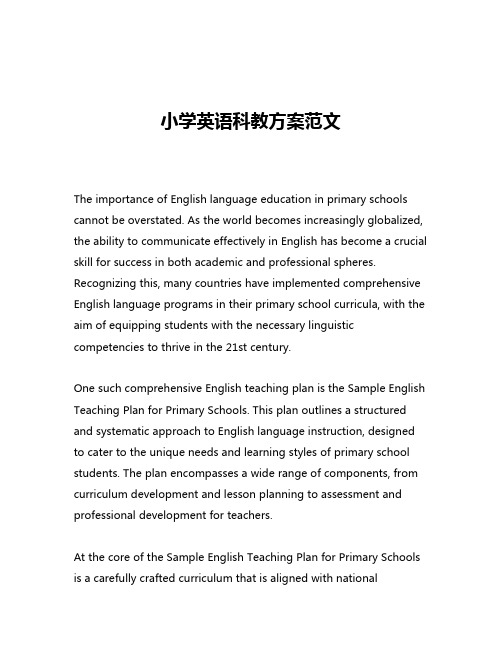
小学英语科教方案范文The importance of English language education in primary schools cannot be overstated. As the world becomes increasingly globalized, the ability to communicate effectively in English has become a crucial skill for success in both academic and professional spheres. Recognizing this, many countries have implemented comprehensive English language programs in their primary school curricula, with the aim of equipping students with the necessary linguistic competencies to thrive in the 21st century.One such comprehensive English teaching plan is the Sample English Teaching Plan for Primary Schools. This plan outlines a structured and systematic approach to English language instruction, designed to cater to the unique needs and learning styles of primary school students. The plan encompasses a wide range of components, from curriculum development and lesson planning to assessment and professional development for teachers.At the core of the Sample English Teaching Plan for Primary Schools is a carefully crafted curriculum that is aligned with nationaleducational standards and the Common European Framework of Reference for Languages (CEFR). The curriculum is organized into a series of progressive levels, each with its own set of learning objectives and targeted language skills. This ensures that students receive a well-rounded and coherent education, with each level building upon the skills and knowledge acquired in the previous one.The curriculum is further divided into thematic units, each focusing on a specific aspect of language learning, such as vocabulary, grammar, reading comprehension, or oral communication. These units are designed to be engaging and relevant to the students' daily lives, incorporating topics and scenarios that are familiar and relatable to them. By doing so, the plan aims to foster a genuine interest in the English language and its practical applications, rather than simply teaching it as a dry academic subject.In addition to the curriculum, the Sample English Teaching Plan for Primary Schools emphasizes the importance of effective lesson planning and delivery. Teachers are provided with detailed lesson plans and teaching resources that incorporate a variety of instructional strategies and activities. These strategies are designed to cater to different learning styles, ensuring that all students have the opportunity to engage with the material in a way that suits their individual needs.One of the key features of the plan is its emphasis on interactive and communicative language learning. Rather than relying solely on traditional lecturing or rote memorization, the plan encourages teachers to create dynamic and engaging learning environments that promote active participation and collaboration among students. This may involve group discussions, role-playing exercises, or project-based learning activities, all of which are aimed at fostering the development of practical language skills.The Sample English Teaching Plan for Primary Schools also places a strong emphasis on assessment and feedback. Regular formative and summative assessments are incorporated throughout the curriculum, providing both teachers and students with valuable insights into their progress and areas for improvement. These assessments are designed to be diverse and comprehensive, ranging from written tests and oral presentations to portfolios and self-evaluation exercises.Recognizing the crucial role that teachers play in the success of any educational program, the Sample English Teaching Plan for Primary Schools also includes a comprehensive professional development component. Teachers are provided with ongoing training and support, including workshops, mentoring programs, and access to a wide range of teaching resources and materials. This ensures that educators are equipped with the necessary knowledge, skills, andstrategies to effectively implement the plan in their classrooms.Furthermore, the plan encourages the integration of technology into the English language learning process. By incorporating digital tools and resources, such as interactive whiteboards, educational apps, and online learning platforms, the plan aims to enhance the learning experience and make it more engaging and accessible for students. This not only helps to keep pace with the rapidly evolving technological landscape but also prepares students for the digital realities of the 21st century.One of the key strengths of the Sample English Teaching Plan for Primary Schools is its adaptability and flexibility. While the plan provides a comprehensive framework for English language instruction, it also allows for a certain degree of customization and adaptation to suit the unique needs and circumstances of individual schools and communities. This ensures that the plan can be effectively implemented in a wide range of educational contexts, from urban centers to rural areas, and from well-resourced schools to those with more limited resources.Overall, the Sample English Teaching Plan for Primary Schools represents a holistic and innovative approach to English language education. By combining a robust curriculum, effective teaching strategies, comprehensive assessment practices, and a focus onprofessional development, the plan aims to equip primary school students with the linguistic and communicative skills necessary to succeed in an increasingly globalized world. As more and more countries recognize the importance of early English language education, the widespread adoption of such comprehensive teaching plans is likely to become a crucial component of educational reform and development in the years to come.。
小学英语教学设计的基本流程
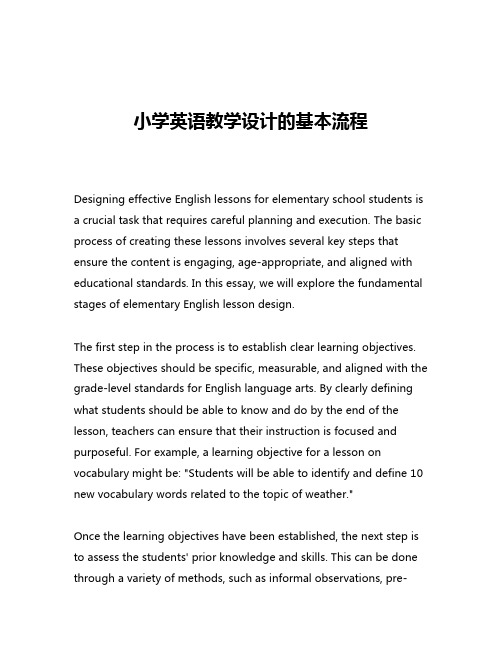
小学英语教学设计的基本流程Designing effective English lessons for elementary school students is a crucial task that requires careful planning and execution. The basic process of creating these lessons involves several key steps that ensure the content is engaging, age-appropriate, and aligned with educational standards. In this essay, we will explore the fundamental stages of elementary English lesson design.The first step in the process is to establish clear learning objectives. These objectives should be specific, measurable, and aligned with the grade-level standards for English language arts. By clearly defining what students should be able to know and do by the end of the lesson, teachers can ensure that their instruction is focused and purposeful. For example, a learning objective for a lesson on vocabulary might be: "Students will be able to identify and define 10 new vocabulary words related to the topic of weather."Once the learning objectives have been established, the next step is to assess the students' prior knowledge and skills. This can be done through a variety of methods, such as informal observations, pre-assessments, or discussions with the students. Understanding the students' current level of understanding and abilities is crucial for designing lessons that are appropriately challenging and engaging.With the learning objectives and student assessment in place, the teacher can begin to plan the lesson's structure and activities. This involves selecting appropriate instructional strategies, materials, and resources that will support the achievement of the learning objectives. For example, a lesson on reading comprehension might include a combination of direct instruction, guided practice, and independent reading activities.When planning the lesson activities, it is important to consider the different learning styles and needs of the students. This may involve incorporating a variety of modalities, such as visual, auditory, and kinesthetic activities, to cater to the diverse learning preferences of the students. Additionally, the teacher should ensure that the activities are age-appropriate and engaging, using a variety of techniques such as games, interactive technology, or hands-on experiments.Another key aspect of lesson design is the assessment of student learning. Throughout the lesson, the teacher should use formative assessments to monitor student progress and adjust instruction as needed. This may involve informal checks for understanding, exittickets, or other assessment tools. At the end of the lesson, the teacher should also use a summative assessment to evaluate the students' mastery of the learning objectives.The final step in the lesson design process is the reflection and evaluation of the lesson. After the lesson has been taught, the teacher should take time to reflect on the effectiveness of the instruction, the engagement of the students, and the achievement of the learning objectives. This reflection can inform future lesson planning and help the teacher to continuously improve their instructional practices.In conclusion, the basic process of designing elementary English lessons involves several key steps: establishing clear learning objectives, assessing student prior knowledge, planning the lesson structure and activities, incorporating diverse learning styles, assessing student learning, and reflecting on the effectiveness of the lesson. By following this process, teachers can create engaging and effective lessons that support the growth and development of their elementary school students.。
小学英语优秀教案设计全英文版

Elementary English Excellent Lesson Plan Design IntroductionIn the realm of elementary education, crafting a well-thought-out lesson plan is essential to ensuring that students effectively grasp the English language. This document aims to provide a comprehensive guide to designing an excellent English lesson plan for elementary school children.Lesson ObjectiveThe primary objective of this lesson plan is to enhance students’ ability to communicate effectively in English. By the end of the lesson, students should be able to demonstrate improved proficiency in listening, speaking, reading, and writing in English.Lesson Outline1.Warm-Up Activity (10 minutes)–Engage students with a short, interactive activity to set the stage for the lesson.2.Vocabulary Building (15 minutes)–Introduce new vocabulary words through interactive exercises such as flashcards and word association games.3.Reading Comprehension (20 minutes)–Present a short reading passage tailored to the students’ proficiency level. Have students read the passage aloud and answercomprehension questions.4.Listening Exercise (15 minutes)–Play an audio clip or video with English dialogue. Have students listen carefully and answer questions based on the content.5.Speaking Practice (20 minutes)–Encourage students to engage in conversations with their peers or the teacher on a given topic. Provide prompts to guide thediscussion.6.Writing Exercise (20 minutes)–Assign a short writing task, such as composing a paragraph ora dialogue. Provide feedback on grammar, spelling, and sentencestructure.7.Wrap-Up Activity (10 minutes)–Review key concepts covered in the lesson through a fun and interactive wrap-up activity.AssessmentAssessment plays a crucial role in evaluating students’ progress and understanding of the lesson. For this lesson plan, assessment can be conducted through: - Observation:Monitor students’ participation, interactions, and engagement throughout the lesson. - Questioning: Ask students open-ended questions to gauge their understanding of the material. - Written Assignments: Review students’ written work to assess their writing skills and comprehension of English concepts. - Peer Evaluation: Engage students in peer review activities to promote collaborative learning and feedback.ConclusionIn conclusion, designing an excellent English lesson plan for elementary school students requires careful consideration of students’ proficiency levels, learning styles, and educational objectives. By incorporating a variety of engaging activities and assessment methods, teachers can create a dynamic and effective learning environment that fosters students’ English language skills.。
小学英语全英教案
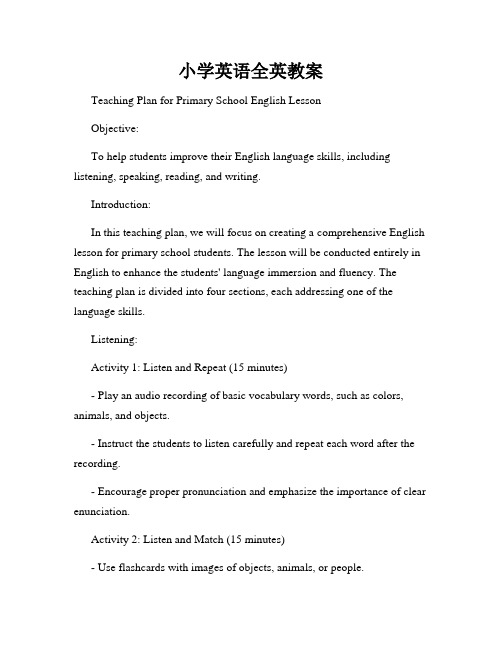
小学英语全英教案Teaching Plan for Primary School English LessonObjective:To help students improve their English language skills, including listening, speaking, reading, and writing.Introduction:In this teaching plan, we will focus on creating a comprehensive English lesson for primary school students. The lesson will be conducted entirely in English to enhance the students' language immersion and fluency. The teaching plan is divided into four sections, each addressing one of the language skills.Listening:Activity 1: Listen and Repeat (15 minutes)- Play an audio recording of basic vocabulary words, such as colors, animals, and objects.- Instruct the students to listen carefully and repeat each word after the recording.- Encourage proper pronunciation and emphasize the importance of clear enunciation.Activity 2: Listen and Match (15 minutes)- Use flashcards with images of objects, animals, or people.- Play an audio recording of short descriptions of each image.- TEach students to listen attentively and match the description with the correct flashcard.Speaking:Activity 1: Role-Play (20 minutes)- Divide students into pairs and assign different roles.- Provide a simple dialogue prompt, such as ordering food at a restaurant or buying a ticket at a movie theater.- Instruct students to engage in a conversation using the target vocabulary and sentences from the prompt.Activity 2: Storytelling (20 minutes)- Provide students with a picture book or a series of pictures depicting a simple story.- Elicit sentences or questions related to the story from the students.- Encourage each student to contribute to the storytelling by using the target language.Reading:Activity 1: Reading Aloud (20 minutes)- Select a short story appropriate for the students' reading level.- Ask individual students to read a paragraph or a few sentences aloud.- Provide guidance on pronunciation and intonation when necessary.Activity 2: Reading Comprehension (20 minutes)- Distribute a worksheet with multiple-choice or fill-in-the-blank questions based on the story.- Instruct students to read the questions and the text carefully, then answer them.Writing:Activity 1: Sentence Construction (15 minutes)- Provide a few simple sentences on the board or in a handout.- Encourage students to rewrite the sentences using their own words while maintaining the same meaning.- Offer guidance on grammar and vocabulary usage.Activity 2: Creative Writing (20 minutes)- Assign a topic for a short written composition, such as "My Favorite Animal" or "A Trip to the Park."- Encourage students to express their thoughts and ideas using the target language.- Provide feedback and corrections after the activity to help students improve their writing skills.Conclusion:By implementing this all-English teaching plan, students can enhance their listening, speaking, reading, and writing skills in English. The plan incorporates various activities targeting different aspects of language learning, offering students an engaging and comprehensive English lesson.。
小学英语教学设计流程模板
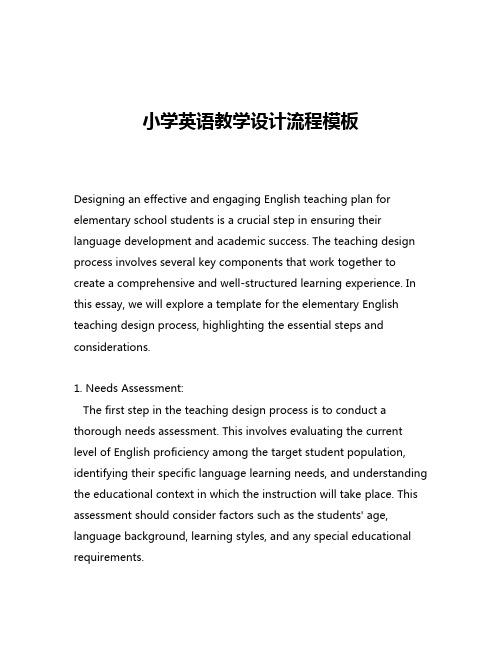
小学英语教学设计流程模板Designing an effective and engaging English teaching plan for elementary school students is a crucial step in ensuring their language development and academic success. The teaching design process involves several key components that work together to create a comprehensive and well-structured learning experience. In this essay, we will explore a template for the elementary English teaching design process, highlighting the essential steps and considerations.1. Needs Assessment:The first step in the teaching design process is to conduct a thorough needs assessment. This involves evaluating the current level of English proficiency among the target student population, identifying their specific language learning needs, and understanding the educational context in which the instruction will take place. This assessment should consider factors such as the students' age, language background, learning styles, and any special educational requirements.2. Curriculum Alignment:Once the needs assessment is complete, the next step is to align the teaching design with the established curriculum and learning standards. This ensures that the instructional objectives, content, and activities are aligned with the overall educational goals and expectations set forth by the school or district. This alignment helps to ensure that the English lessons contribute to the students' overall language development and academic progress.3. Instructional Objectives:With the needs assessment and curriculum alignment in place, the teaching design process moves on to establishing clear and measurable instructional objectives. These objectives should outline the specific language skills, knowledge, and competencies that the students are expected to acquire by the end of the instructional period. The objectives should be specific, measurable, achievable, relevant, and time-bound (SMART) to guide the development of the lesson plans and assessment strategies.4. Content Selection and Organization:The next step in the teaching design process is to select and organize the instructional content. This involves identifying the key language concepts, vocabulary, grammar structures, and communicative functions that will be the focus of the lessons. The content should be sequenced in a logical and progressive manner,building upon previous knowledge and skills to ensure a coherent and scaffolded learning experience.5. Instructional Strategies and Activities:With the content in place, the teaching design process focuses on selecting and designing appropriate instructional strategies and activities. This may include a variety of teaching methods, such as direct instruction, cooperative learning, project-based learning, or task-based learning, depending on the specific learning objectives and the needs of the students. The activities should be engaging, interactive, and promote active participation and language practice.6. Assessment and Evaluation:Ongoing assessment and evaluation are crucial components of the teaching design process. This involves developing formative and summative assessment strategies to measure the students' progress and the effectiveness of the instructional approach. Formative assessments, such as classroom observations, quizzes, and performance-based tasks, can provide valuable feedback to guide instructional adjustments and personalize the learning experience. Summative assessments, such as end-of-unit exams or project presentations, can evaluate the students' overall language proficiency and mastery of the instructional objectives.7. Differentiation and Adaptation:Recognizing that students have diverse learning needs and preferences, the teaching design process should incorporate strategies for differentiation and adaptation. This may involve providing alternative learning materials, scaffolding support, or offering flexible instructional approaches to cater to the diverse needs of the students. By differentiating the instruction, teachers can ensure that all students have the opportunity to engage with the content and achieve the desired learning outcomes.8. Reflection and Refinement:The final step in the teaching design process is to engage in ongoing reflection and refinement. This involves regularly evaluating the effectiveness of the instructional plan, gathering feedback from students and colleagues, and making necessary adjustments to improve the quality and impact of the English lessons. This reflective practice helps to ensure that the teaching design remains relevant, responsive, and continuously evolving to meet the changing needs of the students.In conclusion, the template for the elementary English teaching design process outlined in this essay provides a comprehensive and structured approach to developing effective and engaging language instruction. By following these steps, educators can create lesson plans that are aligned with curricular standards, tailored to the specific needs of their students, and designed to foster languagedevelopment and academic success. Ultimately, the teaching design process is a dynamic and iterative process that requires ongoing reflection, evaluation, and refinement to ensure the continued growth and progress of elementary school students in their English language learning journey.。
小学阅读教学设计英文版

小学阅读教学设计英文版Primary School Reading Teaching DesignIntroduction:Reading is an essential skill that serves as the foundation for learning and personal growth. Developing effective reading skills at a young age is crucial to a student's academic success. This article aims to present an English version of a teaching design for primary school reading education. The design emphasizes interactive and engaging activities to enhance students' reading comprehension and language proficiency.I. Learning Objective:The primary goal of this teaching design is to improve students' reading abilities in English. By the end of the lessons, students should be able to:1. Understand and interpret English texts accurately.2. Apply various reading strategies to extract information.3. Enhance vocabulary and comprehension skills.4. Develop critical thinking and analytical skills.II. Teaching Materials:1. Reading passages or stories appropriate for the primary school level.2. English-English dictionaries.3. Flashcards with target vocabulary words.4. Whiteboard or blackboard and markers.5. Worksheets for comprehension exercises.6. Educational games and activities related to reading.III. Teaching Methodology:1. Pre-Reading Activities:a. Warm-up: Start the lesson with a short conversation or an engaging question related to the reading material to activate students' prior knowledge.b. Vocabulary Preview: Introduce new vocabulary words that are essential for understanding the text using flashcards or visual aids.c. Predictions: Encourage students to make predictions about the content of the text based on the title, illustrations, or initial sentences.2. While-Reading Activities:a. Silent Reading: Provide the students with a printed copy of the text and allow them time to read silently. This helps develop individual reading skills and comprehension abilities.b. Group Reading: Divide students into small groups and assign specific parts of the text to each group member. Instruct them to read aloud and discuss the content together, fostering collaboration and interactive learning.c. Comprehension Questions: Ask a series of guided questions related to the text to ensure students' comprehension and encourage them to think critically about the content.d. Note Taking: Encourage students to take notes or underline important information while reading, enhancing their analytical skills.3. Post-Reading Activities:a. Vocabulary Expansion: Guide students to identify new words from the text and find their meanings using English-English dictionaries. Discuss the contextual usage of these words to reinforce vocabulary acquisition.b. Discussion and Reflection: Engage students in group or whole-class discussions about the themes, characters, or main ideas of the text. Encourage them to share their opinions and relate the reading material to their own experiences.c. Extension Activities: Assign homework tasks that require students to create a simple book review, write a summary, or illustrate their favorite scene from the text. This encourages creativity and further engagement with the material.d. Reinforcement Games: Introduce educational games like word puzzles, matching exercises, or role plays to review the key concepts and vocabulary learned during the lesson.IV. Assessment:Assessment is essential to measure students' progress and identify areas that need improvement. The following assessment methods can be used:1. Oral Assessment: Conduct individual or group discussions to evaluate students' comprehension, critical thinking, and communication skills.2. Written Exercises: Assign worksheets or short writing tasks that require students to demonstrate their understanding of the text, vocabulary usage, or summarizing skills.3. Reading Fluency: Monitor students' reading fluency and accuracy through regular reading sessions or by recording their readings.4. Classroom Observations: Observe students' participation, engagement, and ability to apply reading strategies during activities and discussions.Conclusion:A well-designed English reading teaching plan for primary school students should prioritize interactive activities, individual and collaborative reading, vocabulary expansion, and critical thinking. This design aims to enhance students' overall reading abilities and foster a love for reading. By implementing this teaching plan, educators can effectively cultivate confident and competent readers at the primary school level.。
小学英语教编教学设计案例范文

小学英语教编教学设计案例范文Title: Lesson Plan for Teaching English in Primary SchoolIntroduction:In this lesson plan, I will outline a comprehensive teaching design for a primary school English class. The lesson will focus on vocabulary building, reading comprehension, and interactive activities to engage students in learning English.Objective:By the end of the lesson, students will be able to:1. Understand and use a variety of new vocabulary words related to daily activities.2. Demonstrate comprehension of a short passage by answering questions correctly.3. Engage in interactive activities to practice speaking and listening skills.Materials:- Flashcards with vocabulary words- Short passage for reading comprehension- Worksheet for practicing vocabulary- Audio recordings for listening activities- Interactive games for speaking practiceProcedure:1. Warm-up (10 minutes):- Greet students and review previously learned vocabulary.- Introduce new vocabulary words related to daily activities using flashcards.- Practice pronunciation and spelling of new words with students.2. Reading Comprehension (20 minutes):- Distribute the short passage to students and ask them to read silently.- Discuss the passage as a class and ask comprehension questions to check understanding.- Have students answer questions individually or in pairs to assess comprehension.3. Vocabulary Practice (15 minutes):- Hand out worksheets with exercises to practice using the new vocabulary words.- Encourage students to complete the exercises independently and then review answers as a class.- Provide feedback and clarification on any challenging words or concepts.4. Listening Activity (15 minutes):- Play audio recordings of daily activities and have students listen carefully.- Ask comprehension questions based on the audio clips to assess listening skills.- Encourage students to respond orally to questions and practice speaking skills.5. Interactive Game (20 minutes):- Divide students into small groups and have them participate in an interactive game related to the lesson.- The game can involve role-playing daily activities or using the new vocabulary in context.- Monitor students' participation and provide feedbackon language use.6. Wrap-up (10 minutes):- Review key vocabulary words and concepts covered inthe lesson.- Assign homework related to the day's lesson, such as writing sentences using the new vocabulary.- Provide positive reinforcement and encourage studentsto continue practicing English outside of class.Conclusion:This lesson plan provides a structured and engaging approach to teaching English in a primary school setting.By incorporating vocabulary building, reading comprehension, and interactive activities, students will have the opportunity to practice and improve their English language skills in a fun and supportive environment.。
小学英语作文教学设计方案
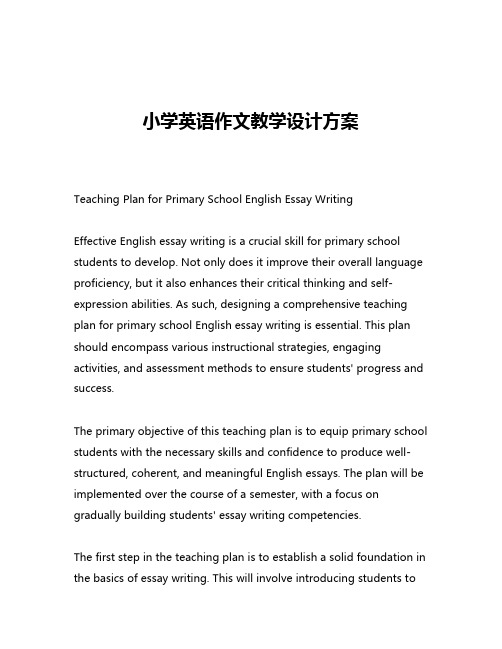
小学英语作文教学设计方案Teaching Plan for Primary School English Essay WritingEffective English essay writing is a crucial skill for primary school students to develop. Not only does it improve their overall language proficiency, but it also enhances their critical thinking and self-expression abilities. As such, designing a comprehensive teaching plan for primary school English essay writing is essential. This plan should encompass various instructional strategies, engaging activities, and assessment methods to ensure students' progress and success.The primary objective of this teaching plan is to equip primary school students with the necessary skills and confidence to produce well-structured, coherent, and meaningful English essays. The plan will be implemented over the course of a semester, with a focus on gradually building students' essay writing competencies.The first step in the teaching plan is to establish a solid foundation in the basics of essay writing. This will involve introducing students tothe fundamental elements of an essay, such as the introduction, body paragraphs, and conclusion. Teachers will guide students in understanding the purpose and structure of each section, as well as the importance of developing a clear thesis statement and supporting it with relevant evidence.To reinforce these concepts, students will engage in a series of interactive activities. For instance, they may be asked to analyze sample essays, identifying the key components and discussing their effectiveness. Additionally, students will practice writing short, structured paragraphs, focusing on the development of topic sentences, supporting details, and concluding statements.As students become more comfortable with the basic essay structure, the teaching plan will shift to the development of specific writing skills. This will include instruction on effective brainstorming and outlining techniques, as well as strategies for organizing and coherently expressing their ideas. Students will be encouraged to experiment with different organizational patterns, such as chronological, compare-and-contrast, and cause-and-effect, to determine which structures best suit their writing style and the given prompts.To further enhance students' writing abilities, the teaching plan will incorporate lessons on grammar, vocabulary, and sentence structure.Students will learn how to construct varied and sophisticated sentences, utilize appropriate transitional phrases, and expand their vocabulary to convey their ideas more effectively. These skills will be reinforced through targeted exercises, peer-editing activities, and individual feedback from the teacher.In addition to the instructional components, the teaching plan will also emphasize the importance of the writing process. Students will be guided through the stages of prewriting, drafting, revising, editing, and publishing. They will learn to view writing as a dynamic, iterative process, where they can refine and improve their work through multiple drafts.To make the writing process more engaging and meaningful, the teaching plan will incorporate various writing prompts and topics that are relevant to the students' lives and interests. This could include personal narratives, persuasive essays on social issues, or analytical pieces on literature or current events. By allowing students to write about subjects that resonate with them, they will be more invested in the writing process and motivated to produce high-quality work.Furthermore, the teaching plan will incorporate peer-review and self-assessment activities to foster students' critical thinking and self-reflection skills. Students will learn to provide constructive feedbackto their classmates, identifying strengths and areas for improvement. They will also engage in self-evaluation, reflecting on their own writing progress and setting goals for future improvement.To assess students' learning and progress, the teaching plan will include a range of formative and summative assessments. Formative assessments, such as in-class writing exercises, short quizzes, and teacher-student conferences, will provide ongoing feedback and allow for timely adjustments to the instructional approach. Summative assessments, such as comprehensive essay assignments and end-of-unit exams, will evaluate students' overall mastery of the targeted skills and knowledge.Throughout the implementation of this teaching plan, teachers will maintain a supportive and encouraging classroom environment. They will provide frequent praise and constructive feedback to build students' confidence and foster a growth mindset. Additionally, teachers will offer individualized assistance and differentiated instruction to cater to the diverse learning needs and abilities within the classroom.By the end of the semester, students will have developed a strong foundation in English essay writing. They will be able to confidently plan, organize, and compose well-structured essays that effectively communicate their ideas and perspectives. Furthermore, students willhave acquired essential writing skills, such as using appropriate grammar, vocabulary, and rhetorical devices, that they can apply across various academic and personal writing contexts.In conclusion, this comprehensive teaching plan for primary school English essay writing aims to equip students with the necessary skills and confidence to become proficient and engaging writers. Through a combination of direct instruction, engaging activities, and targeted assessments, students will embark on a journey of self-expression and intellectual growth, ultimately preparing them for future academic and personal writing challenges.。
2024年小学英语教学设计

2024年小学英语教学设计小学英语教学设计1一、以活动为核心,教师为指导。
以学生为本,让学生学会学习、学会创新、自主发展。
学案导学的教学模式提高了学生自主学习的积极性与主动性,通过学案,教师更能够传授给学生更好的学习方法,对教师的要求也更加高了。
学案导学能够让学生更加牢固的掌握所要学的知识,化被动为主动,让学生从“要我学→我要学”,这一思想的转变让新课程理念更好地体现出来了。
导学案的设计要从教材的编排原则和知识系统出发,对教材和教参资料以及自己所教学生的认知能力和认知水平等进行认真的分析研究,合理处理好教材,把握好对教材的翻译,要把教材中深奥的,不易理解的抽象的知识翻译成能读懂易接受的、通俗的、具体的知识。
二、以学生为本,让学生学会学习、学会创新。
帮助学生更有效地进行学习,导学案要做到重点突出,导学和探究的问题能引发学生兴趣,这就需要我们老师发挥集体的力量,进行集智备课,我想一份好的导学案一定要符合你班级的现实特点,通常我觉得首先老师应该进行初备课,把自己预设的问题和想法在集智备课中反映出来,俗话说人多力量大,再进行取其精华,摈弃糟粕,进行三次备课,这样的一份导学案实用性才会更强。
三、是师生共用和参与的良好互动载体。
教案,是教师教学活动的设计。
过去,我们教师备课都是自己备课,把备课的各个环节呈现在备课本中,上课都是用传统模式,学生按照教师设计的那样一步一步学,教师似乎成了课堂的主体,而学案,就是学生学习活动的设计。
在课堂学习环节,同学都能积极参与,合作学习和自主学习相结合。
四、重视个体差异,促使学生全面主动地发展。
现代教学关注学生个性的发展。
教师不仅要使用导学案,更要创造性地使用导学案。
教师在使用导学案的过程中,要注意结合自己学生的实际情况创造性地使用导学案,可以变化其中的某些环节,使其更符合学生的实际,更易于操作,不可一味地照搬照用。
在课堂上学生除了听教师讲课之外,还有更多的事情做,能够主动学习,边学边练、边讲边练,使学生能更好的掌握知识。
小学外研版英语教学计划
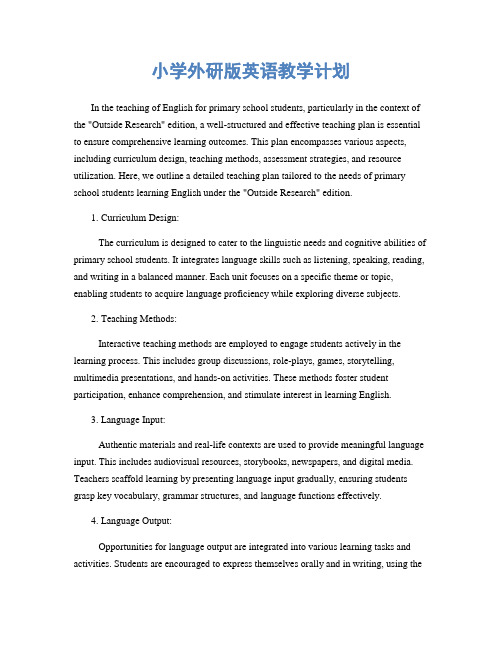
小学外研版英语教学计划In the teaching of English for primary school students, particularly in the context of the "Outside Research" edition, a well-structured and effective teaching plan is essential to ensure comprehensive learning outcomes. This plan encompasses various aspects, including curriculum design, teaching methods, assessment strategies, and resource utilization. Here, we outline a detailed teaching plan tailored to the needs of primary school students learning English under the "Outside Research" edition.1. Curriculum Design:The curriculum is designed to cater to the linguistic needs and cognitive abilities of primary school students. It integrates language skills such as listening, speaking, reading, and writing in a balanced manner. Each unit focuses on a specific theme or topic, enabling students to acquire language proficiency while exploring diverse subjects.2. Teaching Methods:Interactive teaching methods are employed to engage students actively in the learning process. This includes group discussions, role-plays, games, storytelling, multimedia presentations, and hands-on activities. These methods foster student participation, enhance comprehension, and stimulate interest in learning English.3. Language Input:Authentic materials and real-life contexts are used to provide meaningful language input. This includes audiovisual resources, storybooks, newspapers, and digital media. Teachers scaffold learning by presenting language input gradually, ensuring students grasp key vocabulary, grammar structures, and language functions effectively.4. Language Output:Opportunities for language output are integrated into various learning tasks and activities. Students are encouraged to express themselves orally and in writing, using thelanguage learned in class. This promotes fluency, accuracy, and confidence in communication.5. Assessment Strategies:Formative and summative assessments are conducted to evaluate students' progress and achievement. Formative assessments, such as quizzes, presentations, and class discussions, provide ongoing feedback to guide instruction. Summative assessments, including tests and projects, measure students' overall language proficiency and mastery of learning objectives.6. Differentiation and Inclusion:Instruction is differentiated to accommodate diverse learning needs and styles. Teachers provide support and extension activities to cater to students with varying abilities and interests. Inclusion strategies ensure equitable access to learning opportunities for all students, including those with special educational needs.7. Integration of Technology:Technology is integrated judiciously to enhance teaching and learning experiences. Interactive whiteboards, educational software, online resources, and communication tools facilitate engagement, collaboration, and autonomy in learning.8. Parental Involvement:Parents are encouraged to participate actively in their children's English learning journey. Regular communication, workshops, and home-based activities enable parents to support and reinforce learning outside the classroom.9. Continuous Professional Development:Teachers engage in continuous professional development to enhance their pedagogical skills, subject knowledge, and instructional strategies. Professional learning communities, workshops, conferences, and online resources support ongoing growth and reflection.10. Feedback and Reflection:Feedback mechanisms are established to solicit input from students, parents, and stakeholders regarding the effectiveness of the teaching plan. Teachers reflect on their practice, identify areas for improvement, and adapt instructional strategies based on feedback and reflection.By implementing this comprehensive teaching plan, primary school educators can create a supportive and stimulating learning environment conducive to the holistic development of students' English language proficiency, communication skills, and cross-cultural understanding.。
人教部编小学英语课件-教学设计 Instructional Design
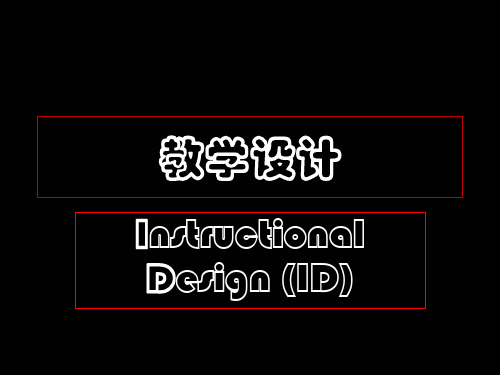
Check: 3 components
_______ design _______ design _______ design
Check: ABCD stand for
•A •B •C •D
Applications of ABCD model
Samples
What’s wrong with this
• An objective is concerned with end product. Read the passage is a process.
• Chang the process to product.
Revision
• Students will read the passage to get the detailed information and the main idea by skimming and scanning.
Mental vs action verbs
• Mental verbs cannot be checked easily; the action cannot be directly observed.
• Change mental verbs to behavioral verbs.
Revision
• The students (A) will be able to match (B) correctly (D) the meanings through the newly learned (C) useful expressions with their English meanings.
Sample 3
• Change from what the TEACHER does to what the STUDENTS can do.
小学英语教学设计范文

小学英语教学设计范文Title: English Teaching Design for Primary School。
Objective: By the end of the lesson, students will be able to identify and use the simple present tense in spoken and written language.Materials: Whiteboard, markers, flashcards, worksheets, and a short story.Warm-up (10 minutes)。
Greet the students and ask them how they are feeling today.Review the days of the week and the weather.Sing a song related to the weather and days of the week.Presentation (15 minutes)。
Introduce the simple present tense using flashcards and examples.Explain the rules for using the simple present tense with verbs.Provide examples of sentences using the simple present tense and ask students to identify the verbs.Practice (20 minutes)。
Divide the class into small groups and give each group a set of flashcards with verbs.Ask each group to create sentences using the simple present tense with the verbs on their flashcards.Walk around the classroom and provide guidance and assistance as needed.Production (20 minutes)。
小学英语优秀教案设计全英文

小学英语优秀教案设计全英文Title: Excellent Lesson Plan Design for Primary School English - All in EnglishIntroductionLanguage learning is a crucial aspect of a child's development process. English as a second language has become a necessity in today's globalized world. Primary school children are introduced to this language to provide them an opportunity to acquire initial language skills that will be helpful for further education and career growth. An excellent lesson plan design is essential to ensure that children learn English effectively. This document presents an exemplary lesson plan designed for primary school English teaching - all in English.ObjectiveThe lesson plan aims to teach primary school children vocabulary and grammar skills related to "Family Members." The lesson plan design is also intended to enhance their literacy and communication skills.Grade Level:This lesson plan is designed for primary school students in the age group of 6 to 8 years.Time:The lesson plan is structured for two sessions of 45 minutes each.Materials and Resources:The following materials and resources will be utilized:- A whiteboard and markers- A PowerPoint presentation on 'Family Members'- Worksheets and handouts for comprehension and grammar practice- Small flashcards of family members- Storybooks like "The Frog Family," "The Family of Bears," etc., to add an element of stories and creativityProcedure:Session 1:1. Teacher introduces the topic "Family Members" by using a PowerPoint presentation. The teacher presents visuals of different family members, including them in a family tree.2. Teacher explains family member's names and their relationship with each other using descriptive words suitable to children.3. Small flashcards are introduced that illustrate the respective family member's images, and a brief discussion is conducted to enhance comprehension and understanding. Children will also have an opportunity to touch and feel the cards, creating a sensory experience.4. The teacher uses different techniques, such as mime and gesture, to explain actions and feelings related to family members to reinforce English language comprehensions.5. The children are given worksheets and handouts related to "Family Members," which includes fill in the blanks, matching games, etc. designed to test their comprehension skills.6. The lesson ends with a brief quiz, assessing their comprehension of the lesson's vocabulary and grammar skills.Session 2:1. With the help of storybooks like "The Family of Bears," "The Frog Family," etc., the teacher will use stories as a tool to teach children how to communicate in English.2. After story time, the teacher will initiate interactive listening and speaking activities that reinforce comprehension skills. By using "I spy" or any other games related to "Family Members," the teacher will keep engaging the children in meaningful communication and develop speaking and listening skills.3. Children will practice writing skills by completing an exercise that requires them to write small paragraphs about their family members.4. The session culminates with a discussion and review of the learning outcomes and skills acquired in the sessions.Assessment and Evaluation:The assessment will involve:1. Quizzes assessing the children's comprehension of vocabulary and grammar skills taught.2. Completion of worksheets and handouts designed to test their comprehension skills.3. Observation of the students' participation in interactive group activities and writing exercise.Conclusion:An effectively designed lesson plan is essential for children to learn English. The above-mentioned lesson plan focuses on teaching vocabulary and grammar skills related to "Family Members." This plan utilizes various teaching techniques, including interactive games, storytelling, and writing exercises. Designed to align with the primary school curriculum, this lesson plan aims to enhance literacy and communication skills. Ultimately, the lesson plan requires careful planning, utilization of diverse resources, and encouragement of meaningful interaction to achieve success.。
英语教学设计模板全英文小学

English Teaching Design Template for Elementary SchoolIntroductionEnglish teaching in elementary school plays a crucial role in laying a strong foundation for students. A well-designed lesson plan is essential to engage young learners and facilitate effective language acquisition. This template provides a structured framework for creating engaging and impactful English lessons for elementary school students.Lesson Objectives1.Develop students’ listening and speaking skills.2.Introduce new vocabulary related to daily activities.3.Enhance students’ ability to communicate in E nglish.4.Foster a positive attitude towards learning English.Lesson StructureWarm-up (10 minutes)•Greet students and engage in a short interactive session to create a lively atmosphere.•Sing a fun English song related to the topic of the lesson.Presentation (15 minutes)•Introduce new vocabulary through flashcards and visual aids.•Use gestures and realia to help students understand the meaning of the words.Practice (20 minutes)•Conduct pair or group activities where students practice using the new vocabulary in context.•Play language games such as word searches or matching exercises to reinforce learning.Production (20 minutes)•Ask students to work on a creative project related to the lesson theme, such as a short skit or a poster.•Encourage students to use the new vocabulary and structures they have learned.Review (10 minutes)•Recap the key points of the lesson through a quick quiz or discussion.•Provide feedback to students on their performance and progress.Assessment•Evaluate students’ understanding of the lesson objectives through informal observation and participation.•Use simple assessment tools like exit tickets or oral presentations to gauge individual progress.Extension Activities•Provide additional resources or homework assignments for students to practice English outside the classroom.•Recommend online language learning platforms or educational apps to support ongoing language development.ConclusionDesigning effective English lessons for elementary school students requires careful planning and creativity. This template serves as a guide to structure engaging and interactive lessons that cater to the diverse learning needs of young learners. By incorporating varied activities and resources, teachers can create a stimulating English learning environment that facilitates language acquisition and fosters a lifelong love for learning.。
小学教师英文设计方案
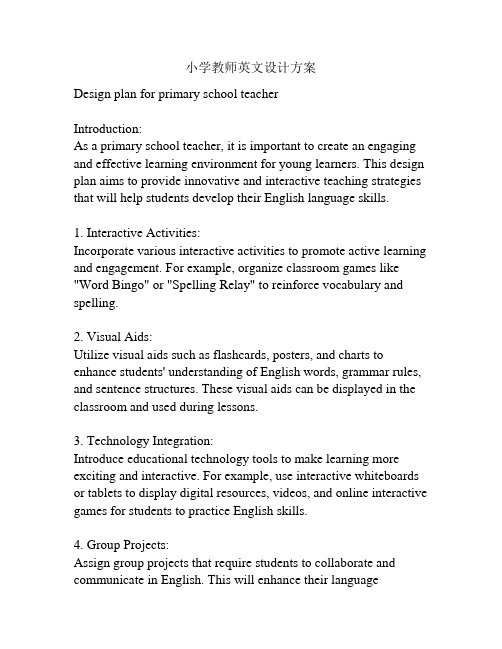
小学教师英文设计方案Design plan for primary school teacherIntroduction:As a primary school teacher, it is important to create an engaging and effective learning environment for young learners. This design plan aims to provide innovative and interactive teaching strategies that will help students develop their English language skills.1. Interactive Activities:Incorporate various interactive activities to promote active learning and engagement. For example, organize classroom games like "Word Bingo" or "Spelling Relay" to reinforce vocabulary and spelling.2. Visual Aids:Utilize visual aids such as flashcards, posters, and charts to enhance students' understanding of English words, grammar rules, and sentence structures. These visual aids can be displayed in the classroom and used during lessons.3. Technology Integration:Introduce educational technology tools to make learning more exciting and interactive. For example, use interactive whiteboards or tablets to display digital resources, videos, and online interactive games for students to practice English skills.4. Group Projects:Assign group projects that require students to collaborate and communicate in English. This will enhance their languageproficiency and teamwork skills. Examples of group projects include creating a short skit, designing a poster, or preparing a presentation on a given English topic.5. Language Games:Incorporate language games into the curriculum to make learning fun and engaging. For instance, play "Simon says" to practice vocabulary, or "Charades" to encourage students to act out English expressions or words.6. Regular Assessments:Implement regular assessments to evaluate students' progress. Use a combination of oral presentations, written tests, quizzes, and project evaluations to assess their language skills and identify areas of improvement.7. Reading Corner:Set up a cozy and inviting reading corner in the classroom. Fill it with age-appropriate English storybooks and encourage students to engage in independent or group reading activities. This will fostera love for reading and improve their reading comprehension skills.8. Cultural Exchange:Introduce cultural exchange activities by teaching students about different English-speaking countries and their traditions. Organize events like "International Food Day" or "Cultural Exhibition," where students can share their knowledge about different cultures in English.Conclusion:By implementing these approaches in the primary school English curriculum, we can create an interactive and engaging learning environment that nurtures students' English language skills. It is essential to continuously adapt and modify these strategies to suit the needs and interests of the students. Through these efforts, students will be motivated to learn and develop a strong foundation in the English language.。
- 1、下载文档前请自行甄别文档内容的完整性,平台不提供额外的编辑、内容补充、找答案等附加服务。
- 2、"仅部分预览"的文档,不可在线预览部分如存在完整性等问题,可反馈申请退款(可完整预览的文档不适用该条件!)。
- 3、如文档侵犯您的权益,请联系客服反馈,我们会尽快为您处理(人工客服工作时间:9:00-18:30)。
• 教学设计是实现教学目标的计划性和决策
• 教学设计是以系统方法为指导的。教学设 教学设计是以系统方法为指导的。
计把教学各要素看成一个系统,分析教学 计把教学各要素看成一个系统, 问题和需求,确立解决的程序纲要, 问题和需求,确立解决的程序纲要,使教 学效果最优化。 学效果最优化。
• 教学设计是提高学习者获得知识、技能的 教学设计是提高学习者获得知识、
• 您认为教学设计一般应该包含哪些环节? 您认为教学设计一般应该包含哪些环节? • 您是怎样理解教学设计、教案(Lesson plan ) 您是怎样理解教学设计、教案(
以及课件(courseware) 以及课件(courseware)的?
一、教学设计的含义
• 宏观层面: 宏观层面:
针对一门课程或一组课题乃至一个完整的教学系统的设计
效率和兴趣的技术过程。 效率和兴趣的技术过程。教学设计是教育 技术的组成部分, 技术的组成部分,它的功能在于运用系统 方法设计教学过程,使之成为一种具有操 方法设计教学过程,使之成为一种具有操 作性的程序。 作性的程序。
三、教学设计的步骤
• 课前系统
教材分析 学生分析(学习需要分析) 学生分析(学习需要分析) 教学目标分析 教学重点与难点 教学方式 教学环境和教学用具
小学英语教学设计
Instructional Design for Primary English
周 侠 zhouxia74@
讨 论:
• 您怎么理解教学设计/教学系统设计? 您怎么理解教学设计 教学系统设计? 教学设计/
(instructional design/instructional system design) design)
• 微观层面: 微观层面:
针对一个班级或单个教学内容所进行的设计与准备
教学设计是根据教学对象和教学目标,确 教学设计是根据教学对象和教学目标, 定合适的教学起点与终点, 定合适的教学起点与终点,将教学诸要素 有序、优化地安排,形成教学方案的过程。 有序、优化地安排,形成教学方案的过程。
二、教学设计的特征
• 教学设计是把教学原理转化为教学材料和
教学活动的计划。教学设计要遵循教学过 教学活动的计划。 程的基本规律来选择教学目标, 程的基本规律来选择教学目标,以解决教 什么的问题。 什么的问题。 性活动。 性活动。教学设计通过计划和布局安排的 形式,对怎样才能达到教学目标进行创造 形式, 性的决策, 解决怎样教的问题。 性的决策,以解决怎样教的问题。
• 课堂系统
课前探究设计 新课导入设计 教学结构(板书结构) 教学结构(板书结构)设计 课堂总结设计
• 课后系统
对学生学习效果的评价 对教学设计的评价
Thanks
